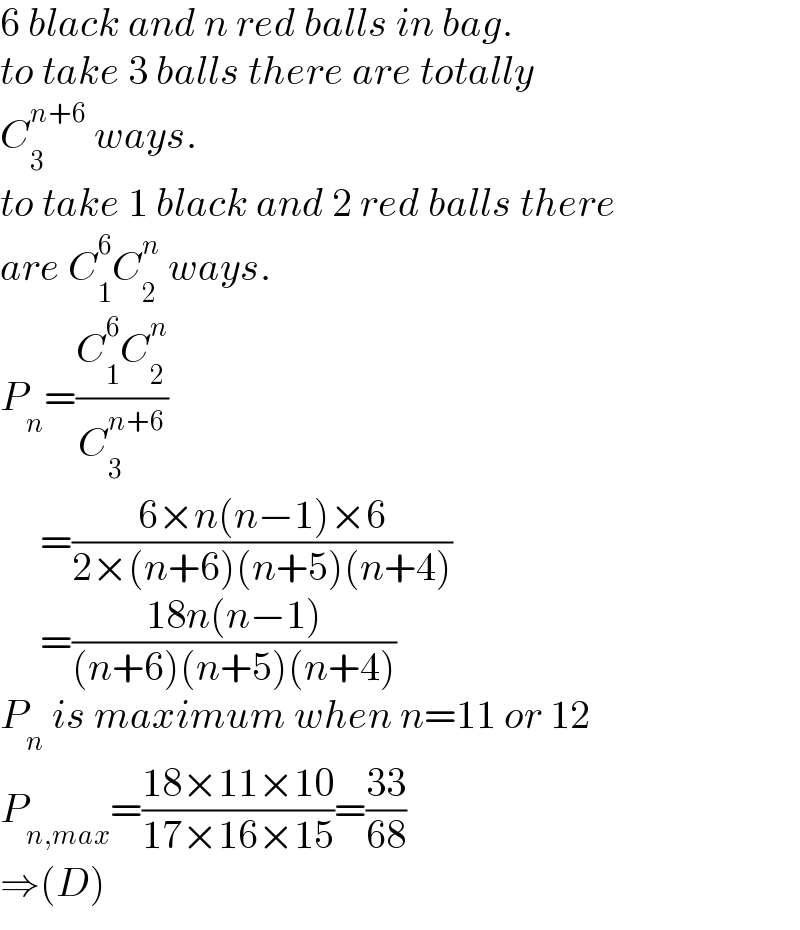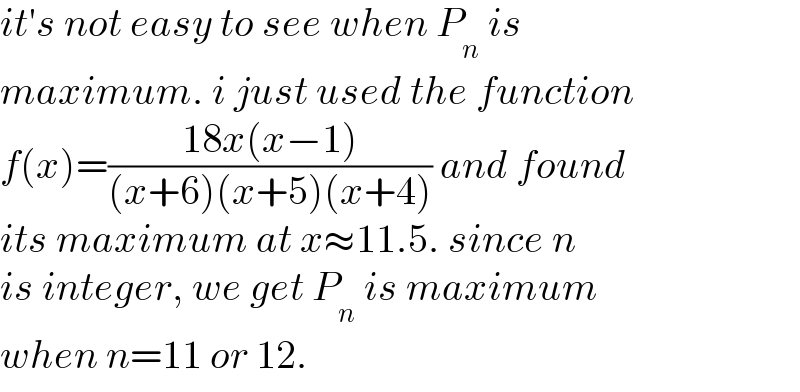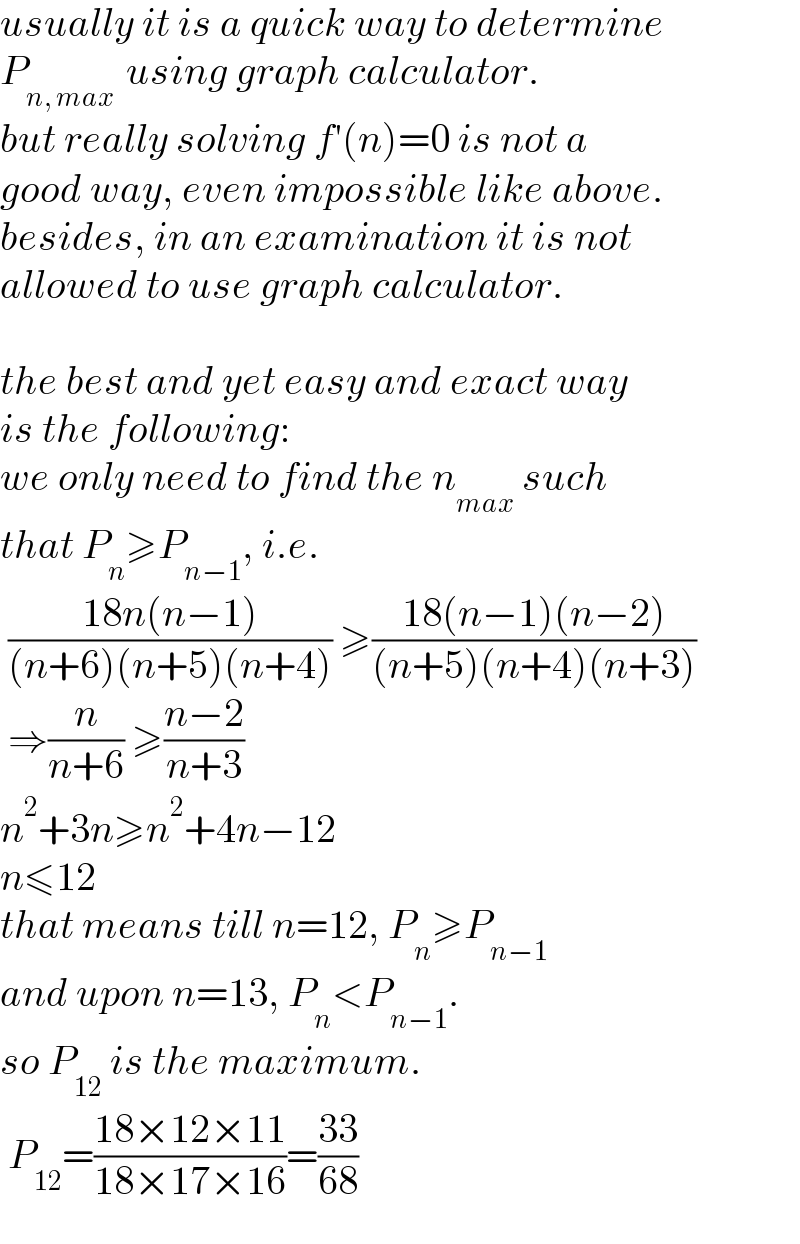
Question Number 177884 by DAVONG last updated on 10/Oct/22

Answered by mr W last updated on 10/Oct/22

$$\mathrm{6}\:{black}\:{and}\:{n}\:{red}\:{balls}\:{in}\:{bag}. \\ $$$${to}\:{take}\:\mathrm{3}\:{balls}\:{there}\:{are}\:{totally} \\ $$$${C}_{\mathrm{3}} ^{{n}+\mathrm{6}} \:{ways}. \\ $$$${to}\:{take}\:\mathrm{1}\:{black}\:{and}\:\mathrm{2}\:{red}\:{balls}\:{there} \\ $$$${are}\:{C}_{\mathrm{1}} ^{\mathrm{6}} {C}_{\mathrm{2}} ^{{n}} \:{ways}. \\ $$$${P}_{{n}} =\frac{{C}_{\mathrm{1}} ^{\mathrm{6}} {C}_{\mathrm{2}} ^{{n}} }{{C}_{\mathrm{3}} ^{{n}+\mathrm{6}} } \\ $$$$\:\:\:\:\:=\frac{\mathrm{6}×{n}\left({n}−\mathrm{1}\right)×\mathrm{6}}{\mathrm{2}×\left({n}+\mathrm{6}\right)\left({n}+\mathrm{5}\right)\left({n}+\mathrm{4}\right)} \\ $$$$\:\:\:\:\:=\frac{\mathrm{18}{n}\left({n}−\mathrm{1}\right)}{\left({n}+\mathrm{6}\right)\left({n}+\mathrm{5}\right)\left({n}+\mathrm{4}\right)} \\ $$$${P}_{{n}} \:{is}\:{maximum}\:{when}\:{n}=\mathrm{11}\:{or}\:\mathrm{12} \\ $$$${P}_{{n},{max}} =\frac{\mathrm{18}×\mathrm{11}×\mathrm{10}}{\mathrm{17}×\mathrm{16}×\mathrm{15}}=\frac{\mathrm{33}}{\mathrm{68}} \\ $$$$\Rightarrow\left({D}\right) \\ $$
Commented by mr W last updated on 10/Oct/22

$${it}'{s}\:{not}\:{easy}\:{to}\:{see}\:{when}\:{P}_{{n}} \:{is}\: \\ $$$${maximum}.\:{i}\:{just}\:{used}\:{the}\:{function} \\ $$$${f}\left({x}\right)=\frac{\mathrm{18}{x}\left({x}−\mathrm{1}\right)}{\left({x}+\mathrm{6}\right)\left({x}+\mathrm{5}\right)\left({x}+\mathrm{4}\right)}\:{and}\:{found} \\ $$$${its}\:{maximum}\:{at}\:{x}\approx\mathrm{11}.\mathrm{5}.\:{since}\:{n} \\ $$$${is}\:{integer},\:{we}\:{get}\:{P}_{{n}} \:{is}\:{maximum} \\ $$$${when}\:{n}=\mathrm{11}\:{or}\:\mathrm{12}. \\ $$
Commented by Acem last updated on 10/Oct/22

$${What}\:{does}\:{the}\:{amount}\:{P}_{{n}} \:{refer}\:{to}? \\ $$
Commented by Acem last updated on 10/Oct/22

$${Does}\:{it}\:{indicat}\:{the}\:{probability}\:{of}\:{this}\:{event} \\ $$$$\:{C}_{\mathrm{1}} ^{\:\mathrm{6}} ×{C}_{\mathrm{2}} ^{\:{n}} \:{occuring}? \\ $$
Commented by mr W last updated on 10/Oct/22

$${yes}.\:{as}\:{the}\:{question}\:{says}:\:{P}_{{n}} \:{is}\:{the} \\ $$$${probability}\:{of}\:{taking}\:\mathrm{1}\:{black}\:{ball}\:{and} \\ $$$$\mathrm{2}\:{red}\:{balls}. \\ $$
Commented by Acem last updated on 11/Oct/22

$$\:{Yes}!\: \\ $$$$\:{f}\left({n}\right)=\:\frac{\mathrm{18}{n}^{\mathrm{2}} −\mathrm{18}{n}}{{n}^{\mathrm{3}} +\mathrm{15}{n}^{\mathrm{2}} +\mathrm{74}{n}+\mathrm{120}}\:\:=\:\boldsymbol{{P}}_{\boldsymbol{{n}}} \\ $$$$\:{f}^{\:'} \left({n}\right)=\:\frac{−\mathrm{18}{n}^{\mathrm{4}} +\mathrm{36}{n}^{\mathrm{3}} +\mathrm{1602}{n}^{\mathrm{2}} +\mathrm{4320}{n}−\mathrm{2160}}{\left({n}^{\mathrm{3}} +\mathrm{15}{n}^{\mathrm{2}} +\mathrm{74}{n}+\mathrm{120}\right)^{\mathrm{2}} } \\ $$$$\:{f}^{\:'} \left({n}\right)=\:\mathrm{0} \\ $$$$\:−\mathrm{18}{n}^{\mathrm{4}} +\mathrm{36}{n}^{\mathrm{3}} +\mathrm{1602}{n}^{\mathrm{2}} +\mathrm{4320}{n}−\mathrm{2160}=\:\mathrm{0} \\ $$$$\:{n}_{\mathrm{1}} \:\cong\:−\mathrm{4}.\mathrm{38}\:,\:{n}_{\mathrm{2}} \:\cong\:−\mathrm{5}.\mathrm{54}\:,\:{n}_{\mathrm{3}} \:\cong\:\mathrm{0}.\mathrm{43}\:{Refuses} \\ $$$$\:\boldsymbol{{n}}_{\mathrm{4}} \:\cong\:\mathrm{11}.\mathrm{5} \\ $$$$\:\begin{cases}{{n}=\:\mathrm{11}\:\Rightarrow\:{P}_{\mathrm{11},\:{max}} =\:\mathrm{0}.\mathrm{485}\:\mathrm{294}\:\mathrm{117}\:\mathrm{647}\:\mathrm{06}}\\{{n}=\:\mathrm{12}\:\Rightarrow\:{P}_{\mathrm{12},\:{max}} =\:\mathrm{0}.\mathrm{485}\:\mathrm{294}\:\mathrm{117}\:\mathrm{647}\:\mathrm{06}}\end{cases} \\ $$$$\: \\ $$$$\boldsymbol{{Note}}:\:{I}\:{got}\:{n}_{\mathrm{1}−\mathrm{4}} \:{from}\:{Graph}\:{calculator} \\ $$$$\:\boldsymbol{{How}}\:\boldsymbol{{can}}\:\boldsymbol{{i}}\:\boldsymbol{{solve}}\:\boldsymbol{{an}}\:\boldsymbol{{equation}}\:\boldsymbol{{ax}}^{\mathrm{4}} +.... \\ $$$$ \\ $$$$ \\ $$
Commented by mr W last updated on 11/Oct/22

$${usually}\:{it}\:{is}\:{a}\:{quick}\:{way}\:{to}\:{determine} \\ $$$${P}_{{n},\:{max}\:} \:{using}\:{graph}\:{calculator}. \\ $$$${but}\:{really}\:{solving}\:{f}'\left({n}\right)=\mathrm{0}\:{is}\:{not}\:{a} \\ $$$${good}\:{way},\:{even}\:{impossible}\:{like}\:{above}. \\ $$$${besides},\:{in}\:{an}\:{examination}\:{it}\:{is}\:{not}\: \\ $$$${allowed}\:{to}\:{use}\:{graph}\:{calculator}. \\ $$$$ \\ $$$${the}\:{best}\:{and}\:{yet}\:{easy}\:{and}\:{exact}\:{way}\: \\ $$$${is}\:{the}\:{following}: \\ $$$${we}\:{only}\:{need}\:{to}\:{find}\:{the}\:{n}_{{max}} \:{such} \\ $$$${that}\:{P}_{{n}} \geqslant{P}_{{n}−\mathrm{1}} ,\:{i}.{e}. \\ $$$$\:\frac{\mathrm{18}{n}\left({n}−\mathrm{1}\right)}{\left({n}+\mathrm{6}\right)\left({n}+\mathrm{5}\right)\left({n}+\mathrm{4}\right)}\:\geqslant\frac{\mathrm{18}\left({n}−\mathrm{1}\right)\left({n}−\mathrm{2}\right)}{\left({n}+\mathrm{5}\right)\left({n}+\mathrm{4}\right)\left({n}+\mathrm{3}\right)} \\ $$$$\:\Rightarrow\frac{{n}}{{n}+\mathrm{6}}\:\geqslant\frac{{n}−\mathrm{2}}{{n}+\mathrm{3}} \\ $$$${n}^{\mathrm{2}} +\mathrm{3}{n}\geqslant{n}^{\mathrm{2}} +\mathrm{4}{n}−\mathrm{12} \\ $$$${n}\leqslant\mathrm{12} \\ $$$${that}\:{means}\:{till}\:{n}=\mathrm{12},\:{P}_{{n}} \geqslant{P}_{{n}−\mathrm{1}} \\ $$$${and}\:{upon}\:{n}=\mathrm{13},\:{P}_{{n}} <{P}_{{n}−\mathrm{1}} . \\ $$$${so}\:{P}_{\mathrm{12}} \:{is}\:{the}\:{maximum}. \\ $$$$\:{P}_{\mathrm{12}} =\frac{\mathrm{18}×\mathrm{12}×\mathrm{11}}{\mathrm{18}×\mathrm{17}×\mathrm{16}}=\frac{\mathrm{33}}{\mathrm{68}} \\ $$
Commented by Tawa11 last updated on 11/Oct/22

$$\mathrm{Great}\:\mathrm{sirs} \\ $$
Commented by Acem last updated on 11/Oct/22

$$\:{The}\:{P}_{{n\_max}} \:\geqslant\:{P}_{{n}−\mathrm{1}} \:{is}\:{a}\:\boldsymbol{{genius}}\:\boldsymbol{{idea}}!! \\ $$$$\:{Big}\:{Thanks} \\ $$$$ \\ $$$$\:\boldsymbol{{Note}}:\:{In}\:{order}\:{to}\:{avoid}\:{the}\:{student}\:{from} \\ $$$$\:\:\:{calculating}\:{the}\:{cases}\:{in}\:{which}\:{n}\:{less} \\ $$$$\:\:\:{than}\:\mathrm{12},\:{in}\:{parallel}\:{with}\:{P}_{{n\_max}} \:\geqslant\:{P}_{{n}−\mathrm{1}} \\ $$$$\:\:\:{we}\:{add}\:{beside}\:{another}\:{logical}\:{inequality}: \\ $$$$\:\boldsymbol{{P}}_{\boldsymbol{{n\_max}}} \:\geqslant\:\boldsymbol{{P}}_{\boldsymbol{{n}}+\mathrm{1}} \:\:\&\:{P}_{{n\_max}} \:\geqslant\:{P}_{{n}−\mathrm{1}} \: \\ $$$$ \\ $$$$\:\frac{\mathrm{18}{n}\left({n}−\mathrm{1}\right)}{\left({n}+\mathrm{6}\right)\left({n}+\mathrm{5}\right)\left({n}+\mathrm{4}\right)}\:\geqslant\:\frac{\mathrm{18}\left({n}+\mathrm{1}\right).{n}}{\left({n}+\mathrm{7}\right)\left({n}+\mathrm{6}\right)\left({n}+\mathrm{5}\right)} \\ $$$$ \\ $$$$\:\:\:\:\:\:\:\frac{{n}−\mathrm{1}}{{n}+\mathrm{4}}\:\geqslant\:\frac{{n}+\mathrm{1}}{{n}+\mathrm{7}}\:\Rightarrow\:{n}\geqslant\:\mathrm{11} \\ $$$$ \\ $$$$\:{Then}\:{we}\:{have}\:\:{n}\leqslant\:\mathrm{12}\:\&\:{n}\geqslant\:\mathrm{11}\:{i}.{e}. \\ $$$$ \\ $$$$\:{n}_{\mathrm{1}} =\:\mathrm{11},\:{n}_{\mathrm{2}} =\mathrm{12}\:{both}\:{achieve}\:{to}\:{be}\:{P}_{\mathrm{11}{or}\:\mathrm{12\_}{max}} \\ $$$$\:{P}_{\mathrm{11}\:{or}\:\mathrm{12}−{max}} =\:\frac{\mathrm{33}}{\mathrm{68}} \\ $$$$ \\ $$$$\:{My}\:{greetings} \\ $$
Commented by Acem last updated on 11/Oct/22

$$\:{It}\:{is}\:{necessary}\:{to}\:{do}\:{that} \\ $$$$\:{Because}\:{from}\:{only}\:{this}\:{n}\leqslant\:\mathrm{12} \\ $$$$\:{the}\:{student}\:{may}\:{think}\:{that}\:{all}\:{values}\:{of}\:{n} \\ $$$$\:{less}\:{than}\:\mathrm{12}\:{i}.{e}.\:\left(\mathrm{12},\:\mathrm{11},\:\mathrm{10}...,\:\mathrm{2}\right)\:{red}\:{balls} \\ $$$$\:{achieve}\:{to}\:{be}\:{P}_{{n}\leqslant\mathrm{12\_}{max}} \\ $$
Commented by mr W last updated on 11/Oct/22

$${then}\:{we}\:{can}\:{do}\:{this} \\ $$$${P}_{{n}} <{P}_{{n}+\mathrm{1}} \\ $$$$\:\frac{\mathrm{18}{n}\left({n}−\mathrm{1}\right)}{\left({n}+\mathrm{6}\right)\left({n}+\mathrm{5}\right)\left({n}+\mathrm{4}\right)}\:<\frac{\mathrm{18}\left({n}−\mathrm{1}\right)\left({n}−\mathrm{2}\right)}{\left({n}+\mathrm{5}\right)\left({n}+\mathrm{4}\right)\left({n}+\mathrm{3}\right)} \\ $$$$\:\frac{{n}}{{n}+\mathrm{6}}\:<\frac{{n}−\mathrm{2}}{{n}+\mathrm{3}} \\ $$$$\Rightarrow{n}>\mathrm{12} \\ $$$${i}.{e}.\:{upon}\:{n}=\mathrm{13},\:{P}_{{n}} <{P}_{{n}+\mathrm{1}} \\ $$$$\Rightarrow{P}_{\mathrm{12}} \:{is}\:{maximum}. \\ $$$${we}\:{don}'{t}\:{need}\:{to}\:{know}\:{whether}\:{P}_{\mathrm{11}} \\ $$$${is}\:{also}\:{maximum}. \\ $$
Commented by Acem last updated on 12/Oct/22

$$ \\ $$$${In}\:{fact}\:{the}\:\frac{\mathrm{18}\left({n}−\mathrm{1}\right)\left({n}−\mathrm{2}\right)}{\left({n}+\mathrm{5}\right)\left({n}+\mathrm{4}\right)\left({n}+\mathrm{3}\right)}\:{is}\:{not}\:{P}_{{n}+\mathrm{1}} \\ $$$${Also},\:{when}\:{we}\:{want}\:{to}\:{set}\:{n}\:{which}\:{make}\:{P}_{{max}} \\ $$$$\:{it}\:{must}\:{be}\:{P}_{{n},\:{max}} \:{greater}\:{than}\:{term}\:{before} \\ $$$$\:{and}\:{after}\:{it}\:{i}.{e}.\: \\ $$$$\:{P}_{{n\_max}} \geqslant\:{P}_{{n}+\mathrm{1}} \:\&\:{P}_{{n\_max}} \geqslant\:{P}_{{n}−\mathrm{1}} \\ $$$$\:{Finally}\:{i}\:{say}\:{that}\:{n}\leqslant\mathrm{12}\:{is}\:{not}\:{enough} \\ $$$$\:{because}\:\mathrm{12}\:{red}\:{balls}\:{makes}\:{P}_{{max}} \\ $$$$\:{and}\:{also}\:\mathrm{11}\:{red}\:{balls}\:{does} \\ $$$$ \\ $$$${In}\:{addition}\:{to}\:{that},\:{the}\:{n}\leqslant\mathrm{12}\:{makes}\:{the} \\ $$$$\:{student}\:{illusion}\:{that}\:{all}\:{values}\:{less} \\ $$$$\:{than}\:\mathrm{12}\:{make}\:{P}_{{max}} \\ $$$$\: \\ $$
Commented by mr W last updated on 12/Oct/22

$${as}\:{i}\:{said}\:{when}\:{we}\:{only}\:{need}\:{to}\:{get}\:{P}_{{n},{max}} \\ $$$${it}'{s}\:{enough}\:{to}\:{know}\:{that}\:{P}_{\mathrm{12}} \:{the} \\ $$$${maximum}.\:{we}\:{don}'{t}\:{need}\:{to}\:{care} \\ $$$${whether}\:{P}_{\mathrm{11}} \:{is}\:{also}\:{maximum}. \\ $$$${from}\: \\ $$$${P}_{\mathrm{1}} \leqslant{P}_{\mathrm{2}} \leqslant{P}_{\mathrm{3}} \leqslant....\leqslant{P}_{\mathrm{11}} \leqslant{P}_{\mathrm{12}} >{P}_{\mathrm{13}} >{P}_{\mathrm{14}} >... \\ $$$${we}\:{can}\:{be}\:{sure}\:{that}\:{P}_{\mathrm{12}} \:{is}\:{the}\:{maximum}. \\ $$$${it}\:{is}\:{not}\:{said}\:{that}\:{only}\:{P}_{\mathrm{12}} \:{is}\:{the} \\ $$$${maximum},\:{but}\:{this}\:{is}\:{for}\:{the} \\ $$$${question}\:{not}\:{important}. \\ $$
Commented by Acem last updated on 13/Oct/22

$$\: \\ $$$${It}'{s}\:{ok}\:{and}\:{good} \\ $$
